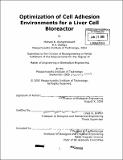Optimization of cell adhesion environments for a liver cell bioreactor
Author(s)
Wongchaowart, Michael B
DownloadFull printable version (2.827Mb)
Other Contributors
Massachusetts Institute of Technology. Biological Engineering Division.
Terms of use
Metadata
Show full item recordAbstract
The MilliF bioreactor offers great potential for the formation of i vivo-like liver tissue outside the body, making it a valuable tool for applications such as drug toxicity models and biosensors. Cell adhesion is an important factor in the maintenance of differentiated hepatocyte functions. Hepatocyte adhesion environments were examined in two settings: spheroid culture prior to seeding in the bioreactor and 2D surface culture methods that could be applied to the bioreactor scaffold. Spheroids were formed either by culturing in spinning suspension or on a static, non-adherent surface. In spheroid culture, the addition of extracellular matrix (ECM) signaling through the use of soluble Matrigel or adhesion protein-coated microspheres did not improve hepatocyte viability or function as assessed by liver-specific gene expression. These results suggest the importance of cell-cell rather than cell-surface interactions in maintaining hepatocytes. Optimal culturing of spheroids in spinning suspension without the ECM addition was found to be 3 days without media changes. 2D surfaces were treated with an adhesion peptide-conjugated comb polymer, preventing nonspecific cell adhesion and allowing attachment through the [alpha]₅[beta]₁ integrin. (cont.) Varying the proportion of adhesion peptide presented to cells was found to regulate hepatocyte morphology and function; a surface with decreased hepatocyte spreading and liver-specific gene expression closer to in vivo was characterized. Immunoblotting for activated focal adhesion kinase (FAK) revealed that FAK signaling was not induced by attachment to the comb polymer surfaces. Immunostaining for other liver cell types demonstrated that the surface allowed hepatic stellate cell and Kupffer cell adhesion.
Description
Thesis (M. Eng.)--Massachusetts Institute of Technology, Biological Engineering Division, February 2006. Includes bibliographical references (p. 40-44).
Date issued
2006Department
Massachusetts Institute of Technology. Department of Biological EngineeringPublisher
Massachusetts Institute of Technology
Keywords
Biological Engineering Division.